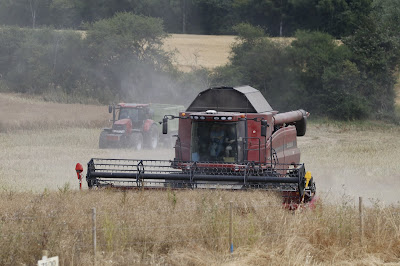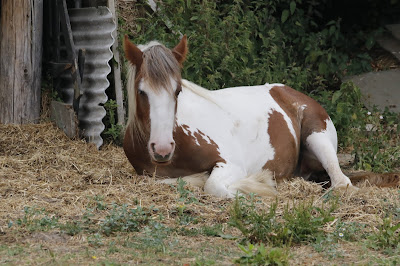I've been trying to diversify my bird watching destinations, because I feel the best way to really appreciate birds is to travel to those places off the beaten track. Yes, Minsmere is great, there is always something good to see there, but there is just something exciting about not really knowing what you might see, a shot in the dark so to say that you would get from the unknown.
So to Havergate Island, Suffolk's least accessible nature reserve (well, tying with Orfordness maybe). With Havergate because it is so inaccessible you don't have any idea about what's about. You have no idea about anything because people can only go there once a month, and not at all in the breeding season. No news comes out of there.
However the local RSPB were doing guided tours all weekend long, where people were able to spend a couple of hours on Havergate with a local birdwatcher.
I know Havergate quite well because despite visiting a few times as a birder I also did volunteer work there. In the late winter/early Spring of 2011 I helped build a screen to a hide to help stop disturbance. However it proved futile as the storm surge of 2013 washed it all away as it did a lot of the island's infrastructure. But when I was there I saw SHORT-EARED OWLS, and a SMEW. It was pretty good.
Anyway back to today's trip. We caught the October Storm from Orford Quay and within fifteen minutes were at the jetty on the island. This is my first visit in five years, and my first since the storm surge so I wasn't sure what I would be seeing.
To be honest it wasn't too much different. The hides were rebuilt and put in different positions, but it didn't really change what we could see. The island is made up of a series of scrapes, surrounded by a sea wall, pools of shallow water with shingle islands and mud. The island is long and thin and the path runs along its spine, north to south.
With scrapes at this time of year the focus is on WADERS. Havergate had a fair number, but it was still fairly quiet. With water levels dropping with the receding tide on the river, WADERS were flying away from the island to feed on the river's mud.
All the usual suspects were around with roosting GODWITS, DUNLIN, REDSHANK OYSTERCATCHER and LAPWING present on all the scrapes. Single numbers of RINGED PLOVERS were dotted about, with the same number of CURLEW, although they are completely different in apppearance. The different scrapes held different number of birds and also different species, all differing in shape, size and colour.
I forget the names of the different lagoons, I know a stupid mistake for a blogger to make, but shoot me. On one scrape was a COMMON SANDPIPER, whilst on another were two KNOT and some TURNSTONE.
We walked down to where the residential area used to be and had coffee and some cake. We then headed back to the jetty and on the way saw six WHIMBREL fly over calling with their seven note trill. We boarded the boat and sailed back to Orford. On the way we saw two SANDWICH TERNS fishing in the river.
To be honest, bird-wise it wasn't great. There wasn't much there, the reserve was very quiet which may have been influenced by the tides of the river. But its been a long time since I have been here, and it is always good to keep up with what's going on in the bird world. Its a fascinating place - for a birder, there's nothing else to do here for normal people - in a fascinating area of the country. And as I said in the beginning its always good to explore different places, even if they end up being not that great.
Friday, 24 August 2018
Tuesday, 14 August 2018
Local Patch - July - 2018
A juvenile ROBIN, all browns at this time in its life.
As in every year June moves into July, the breeding season winds down and birds start thinking about migration. This month has been a scorcher, with temperatures regularly hitting thirty degrees, and with no sign of any rain, everything has been burned. Despite some early starts, birds have been difficult to find let alone photograph.
LINNETS are still fairly common on the patch with birds starting to form small flocks after a successful breeding season.
LESSER BLACK BEACKED GULLS often wander aimlessly over the fields.
SWALLOWS nest in the local farm buildings, they can often been seen flying over the Suffolk Punch Field and the Reservoir.
GREENFINCHES have successfully nested on the patch this year. Once a common bird their numbers have crashed due to a pestilence in their species.
Surprisingly BULLFINCHES have been more noticeable this month with birds seen on several days despite being missing for a large chunk of the year before. This must be local birds passing through, the first signs of Autumn. Unfortunately I didn't see any young birds.
BLACKBIRDS are common breeders on the patch, nesting in every hedgerow and area of scrub.
A combine harvester cutting the wheat in Lark's Field mid-July
A large part of the countryside of the Patch is given over to horse grazed meadows. This one is taking a well earned snooze in the scorching sun.
A big influx of CANADA GEESE on the pond, an unusual sight at this time of year.
This REDPOLL COW took offence at me hanging around taking photos.
The stream - a glorified ditch - dried up for the first time I have visited the patch in six years.
Monday, 6 August 2018
Minsmere - 1/8/2018
A COMMON TERN family nesting in front of East Hide. The male would often fly in and feed the mother and chick.
As another month passes so a trip to Minsmere beckons. I know its not a very original decision, and its not like I'm discovering new territory, but its Minsmere and deserves a look every so often, just because of all the birds I can see there. Also it was to be my brother's last birdwatching trip with me, after ten months of hanging around Suffolk he is finally off to the States to live. This will be a farewell trip to Minsmere for my brother, so I was hoping it would live in memory. He will be missed as we have had some good birding trips and he has kept me company on otherwise lonely walks.
I took the train to Saxmundham and met up with my brother at the station and we drove to Minsmere. Upon entering the reserve it was clear it was going to be busy with people. In fact we were unable to get upstairs seating on any of the hides, having to sit downstairs with the more restricted views. Bugger the school holidays.
We did the usual circuit of the Scrape, starting at the North Hide, which as usual was very much overgrown, restricting views, and any bird life was distant.
View from North Hide over West Scrape to Sizewell B. As you can see it is very overgrown with birds quite distant.
We left the North Hide, passing the North Bushes which were quiet as small bird migration hadn't quite started yet. The Stone Curlew Field was also quiet. We found out from a volunteer that no STONE CURLEWS had nested there this year, but a further nine had done so dotted across the rest of the reserve.We went further past North Wall to the sea where little was present except fishing TERNS and passing GULLS. From the beach there is access to East Hide providing good views of the Scrape. What was immediately obvious was how quiet the Scrape was. All the BLACK HEADED GULLS had fledged their young and had moved on leaving it a very quiet place. Of the breeding birds only COMMON TERNS were still left, although not in particularly high numbers, most now raising their chicks.
Of course being August it was all about WADER passage which the Scrape at Minsmere excels in drawing in. At this time of year the Scrape dries out creating lots of mud for WADERS to feed on.
On all the areas of the Scrape were flocks of GODWIT and DUNLIN; with smaller numbers of TURNSTONE and RINGED PLOVER dotted about the place. On East Scrape there was one COMMON SAND; one GREEN SAND; several RUFF were also present looking scruffy as they moult out of breeding plumage; and three SNIPE were also present.
Two summer plumaged TURNSTONE with a grey SPOT SHANK behind.
In the last post on Minsmere (Minsmere 12/7/2018) it was noted we saw a tiny RINGED PLOVER chick on the beach. Now returning three weeks later we discovered it had survived and thrived and was now near fledging, which is great news from an underfire species. Also around the beach area a pair of STONECHATS were still about.
Further along is the Public Viwepoint, a wooden structure just down the beach from East Hide, which doesn't have a roof - so its not a hide. From there it overlooks South Scrape which was also good for WADERS with around 16 SPOT SHANK - now sadly moulting out of their jet black breeding plumage into something greyer; three KNOT and single GREENSHANK.
As well as being full of WADERS, South Scrape was home to a few roosting and nesting TERNS. Most interesting were the two BLACK TERNS, now moulted out of their black summer finery, with black wings and grey-white body with a black ear tuft and also being slightly smaller than a COMMON TERN. These were birds that used to nest in the UK but disappeared with the draining of marshland for farming. Also present was a LITTLE TERN, and probably thinking about going off on migration, this species leaves early.
East Scrape - as the water dries out lots of mud is exposed providing food for WADERS.
We went on to the Wildlife Lookout (West Hide) but on the way passed two wardens with strimmers who went out on the Scrape and scared everything away. As this isn't a particularly important time of year management is often taken out now, sometimes resulting in lots of disturbance.
RINGED PLOVER on the beach. The automatic focus on my camera had a field day with this shot.
We continued over to the reedbed hides but needn't have bothered. Bittern Hide was as crowded as usual, although I don't understand why as I hardly see anything from there. Island Mere held a flock of GADWALL, but again little else. We even failed to see a single MARSH HARRIER, maybe for the first time ever at Minsmere.It was a good farewell to Minsmere for my brother with a good range of WADERS and TERNS present. Unfortunately it was very busy human-wise as happens in the school holidays because Minsmere is the crown jewel of bird reserves and attracts tourists from the non-birdwatching world. Such things are important to keep the RSPB going, maybe enticing a new generation to catch the birding bug.
Subscribe to:
Posts (Atom)




















